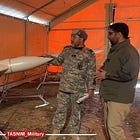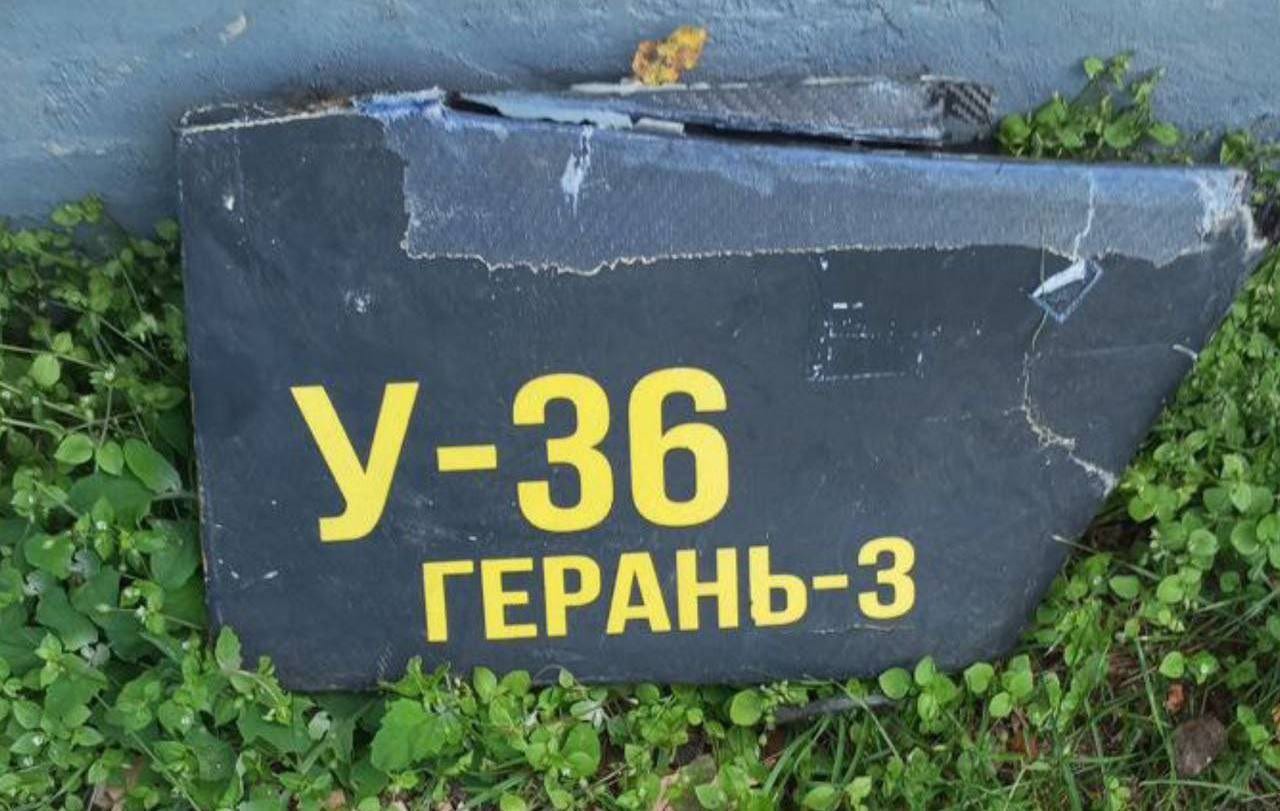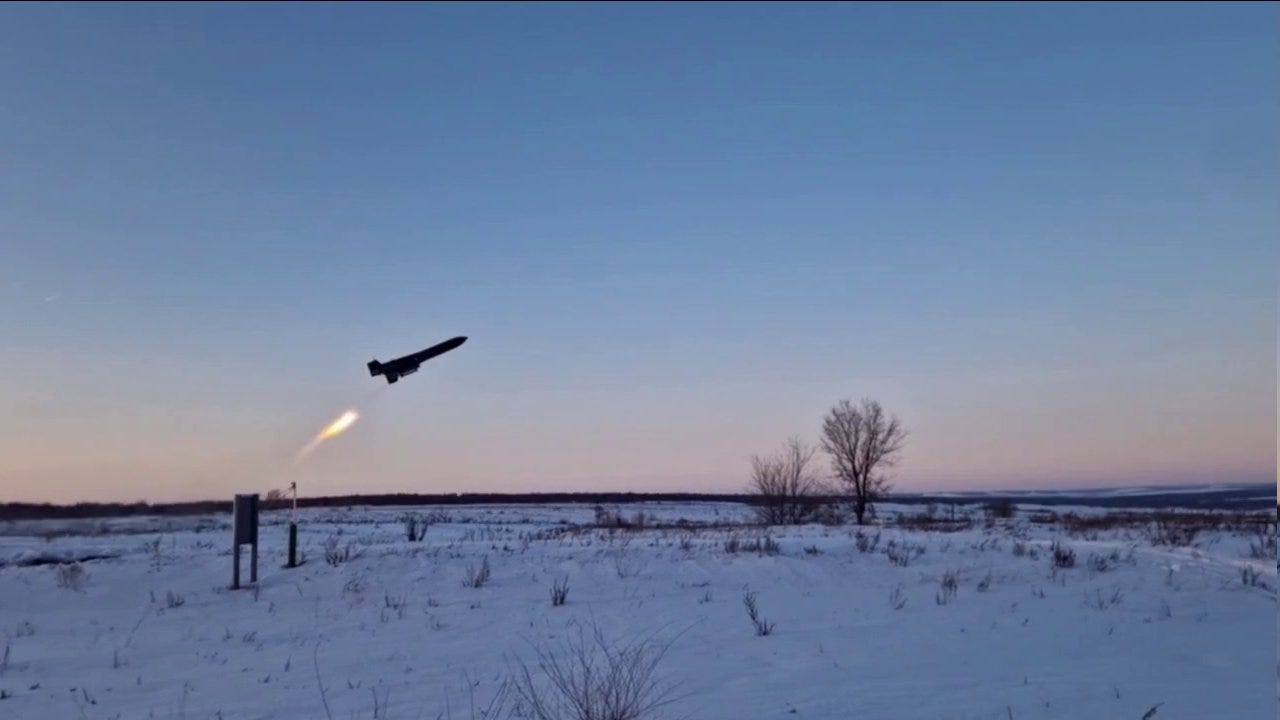Video Offers A Glimpse Of A Russian Turbojet-Powered Version Of The Shahed-136/Geran/Garpiya Strike Drone, Which May Or May Not Be Related To The Geran-3
🇷🇺 🇺🇦
Note: This post expands upon a thread I posted on X/Twitter in June.
While Ukrainian reports have previously indicated Russian interest in and the very limited scale deployment of a turbojet-powered version of the Iranian Shahed-136 cropped delta wing propeller-driven strike drone design, an undated winter video that began circulating on Telegram in June 2025 indicates that Russia may have independently developed its own distinct and seemingly ad hoc turbojet-powered version of the Shahed-136/Geran-2/Garpiya strike drone design. If this interpretation is accurate, the turbojet-powered Geran-3 that both Russian and Ukrainian sources are increasingly referring to may reflect a distinctively Russian branch of a cropped delta wing strike drone evolutionary tree that originated in Iran.
Background on Turbojet-Powered Versions of the Shahed-136 Design Family
In September 2023, Iran informally unveiled a turbojet-powered version of the Shahed-136 that was later formally unveiled with the designation Shahed-238. The revelation that Iran had, in effect, developed a faster—and much more expensive—version of the Shahed-136 received considerable interest on the part of observers of the Russia-Ukraine War. A significantly faster—and higher-flying—turbojet-powered version of the Shahed-136 would be far more difficult for Ukraine to successfully intercept with inexpensive and plentiful machine guns and autocannons, which Ukraine was—and remains—heavily reliant upon to compensate for an enduring shortfall of surface-to-air missile batteries and associated surface-to-air missile interceptors.
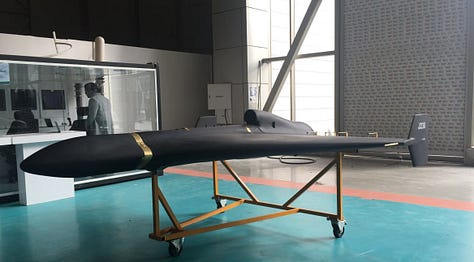
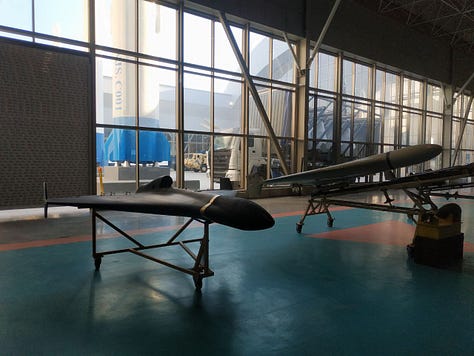
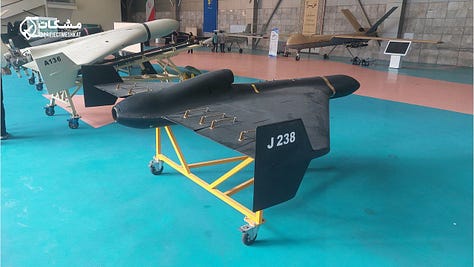
While a turbojet-powered version of the Shahed-136 in the form of the Shahed-238 could fly at a higher speed and a higher altitude, this would increase its exposure to surface-to-air missiles of various types, including fairly low-cost and widely available imaging infrared-guided shoulder-fired surface-to-air missiles (“MANPADS”). For Ukraine, this would be a mixed blessing: the higher unit cost and a likely bottleneck in the area of turbojet engine production would likely result in fewer Russian turbojet-powered Shahed-238 or similar flying in Ukrainian airspace but most if not all Russian Shahed-238 or similar or similar would likely have to be intercepted with surface-to-air missiles that would always to be more expensive and more limited in supply that the ammunition used with machine guns and autocannons.
While observers of the Russia-Ukraine War anticipated that Russia would deploy the Shahed-238 against Ukraine, this development did not come to pass even though the Russian manufacturer of the Shahed-136 is understood to have unsuccessfully pitched the M-237—which appears to be the Russian manufacturer’s proposed designation for the Iranian Shahed-238—to the Russian military.
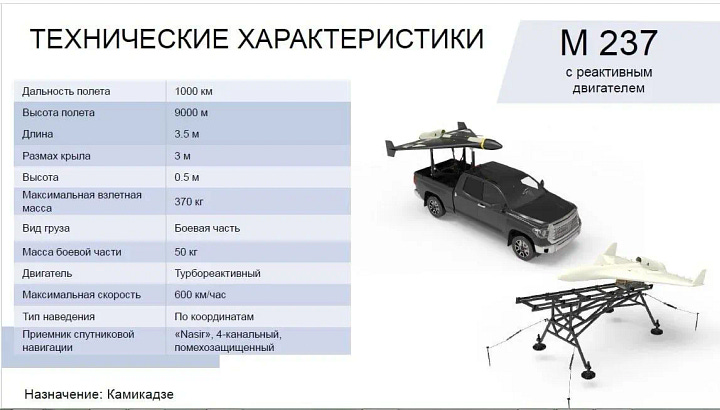
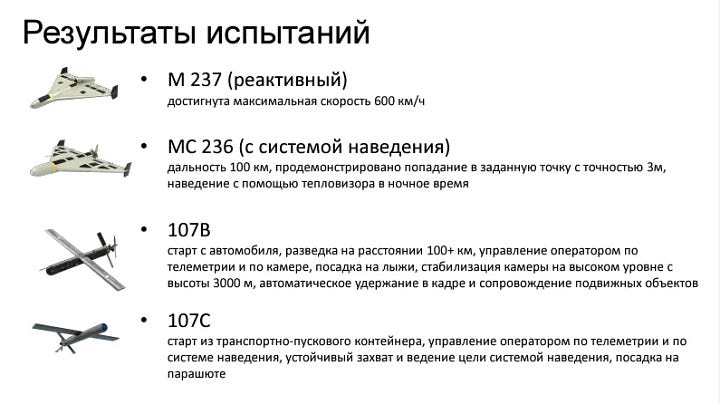
It is possible, even likely, that the Russian military did not see the appeal of the Shahed-238 turned M-237 given what is likely to have been a much higher unit cost. It is also possible that the Russian military was pessimistic about Russia’s ability to establish local production of a suitable small turbojet engine at a time when Russia was primarily prioritizing the mass production of existing systems at expanded existing production lines. The Shahed-136/Geran-2 was and remains one of the most notable exceptions to this dynamic beyond the peculiar area of "armed “first-person video” multirotor drones, the production of which relies heavily on imported commercial-off-the-shelf components.
While the Russian military appears to have decided against procuring the Shahed-238 in the form of the M-237, the design continued to evolve within Iran. At the time of its formal unveiling in November 2023, Iran displayed the Shahed-238 in a baseline version that was wholly reliant on an inertial navigation system complemented by a Global Navigation Satellite System (GNSS) receiver, as well as one, possibly two, versions that were equipped with nose-mounted sensors. Although the Shahed-238 offered, in principle, Iran a significant capability upgrade notwithstanding the partial overlap of this turbojet-powered derivative of the Shahed-136 with the larger and heavier Paveh family of cruise missiles, the Shahed-238 was not heard of again, and its production and operational status was—and remains—uncertain.
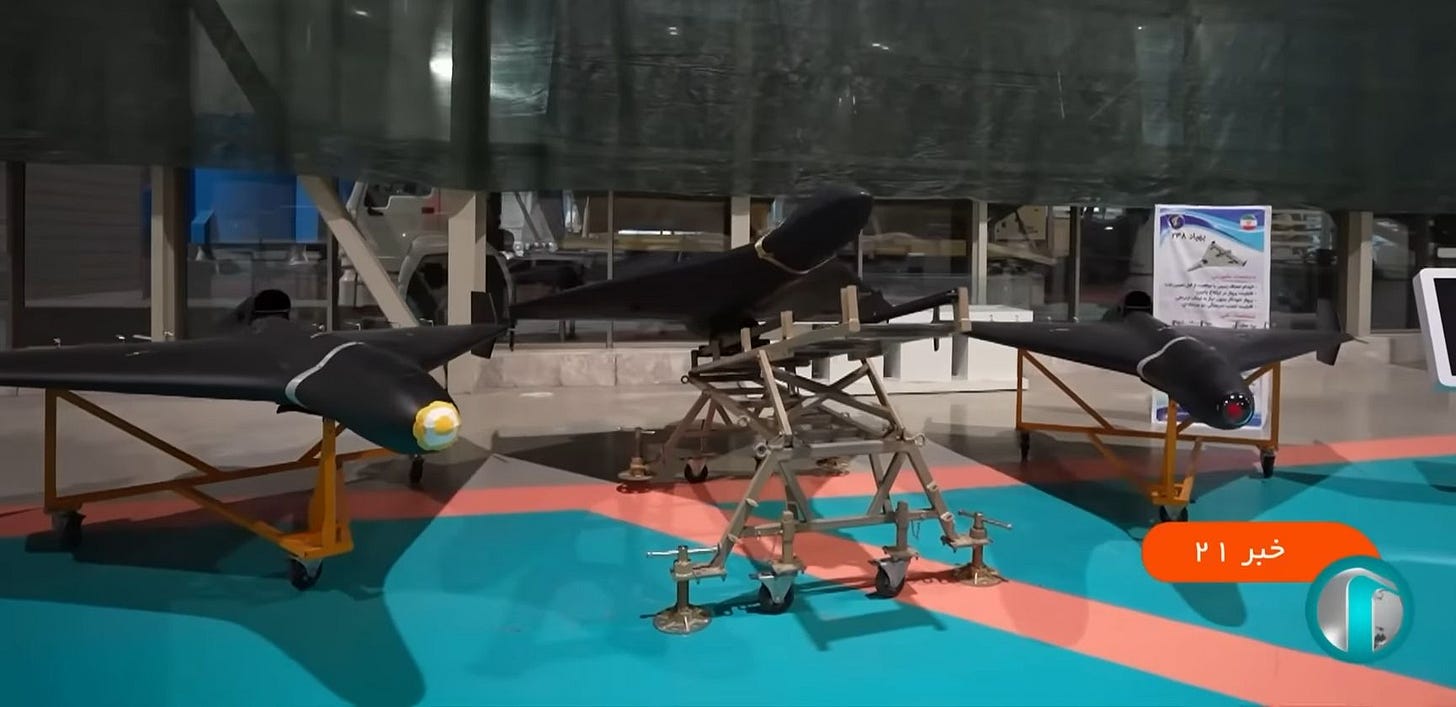
In September 2024, Iran formally unveiled a distinctive turbojet-powered cropped delta wing design—a winged cruise missile—that was confusingly designated “Shahed-136 jet.” While the “Shahed-136 jet” was unmistakably a member of the Shahed-136 design family, it was not identical to the Shahed-238 and did not share the latter’s designation. The most obvious difference could be found in the wing stabilizers, which were of a different shape than those found on the propeller-driven Shahed-136.
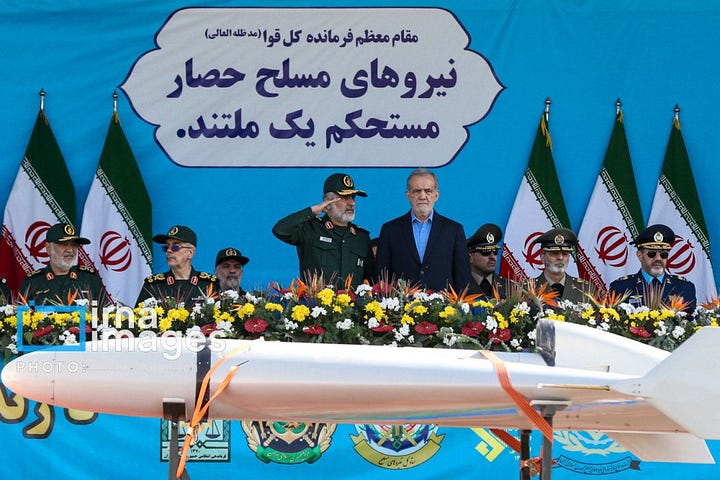
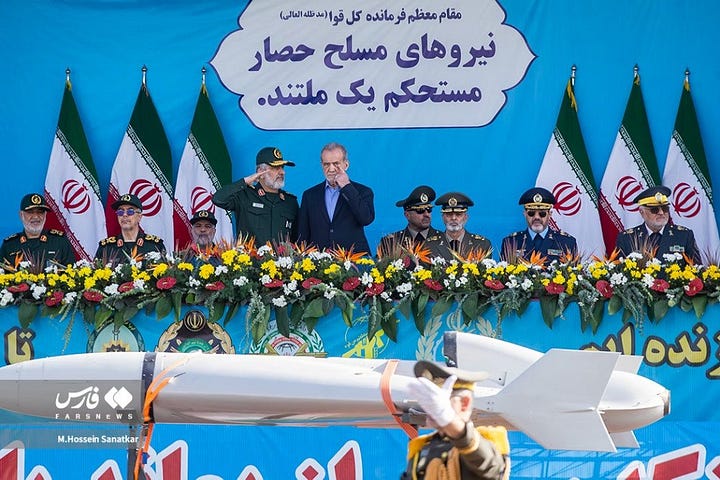
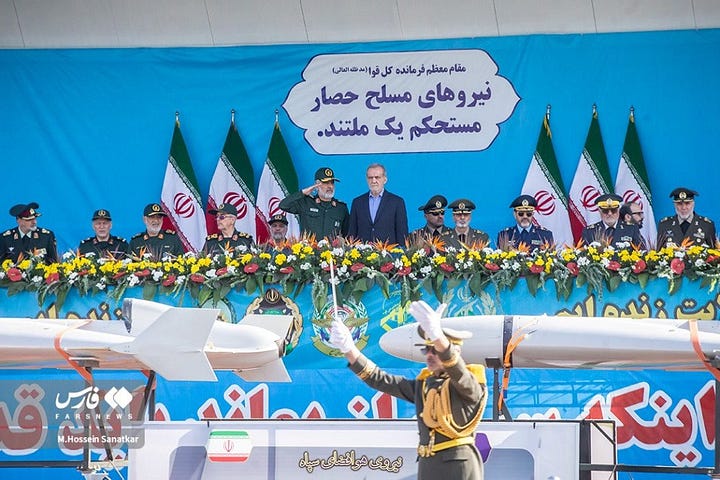
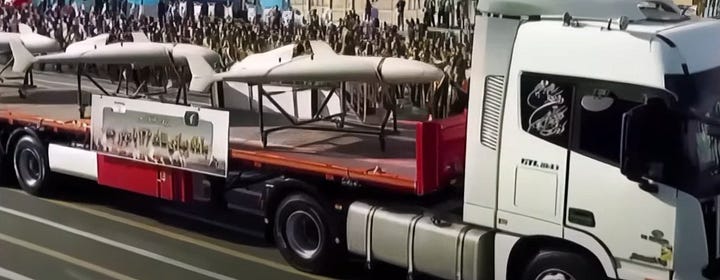
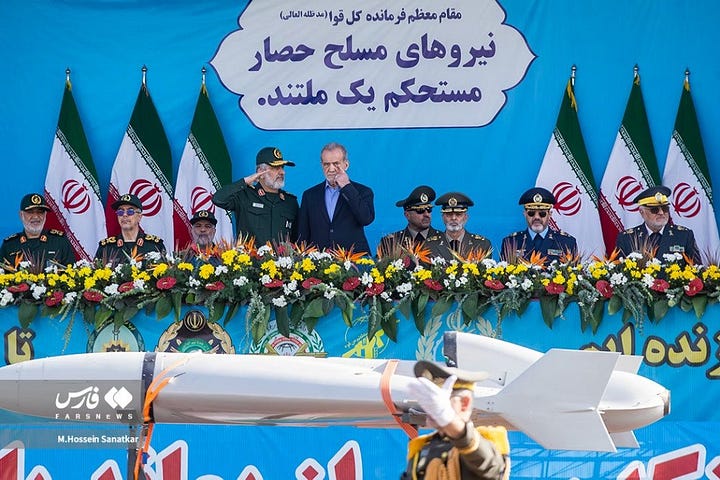
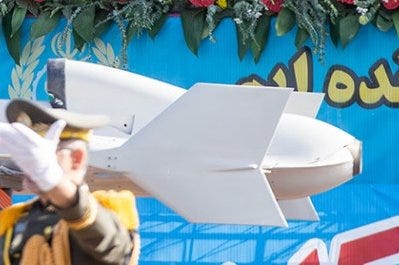
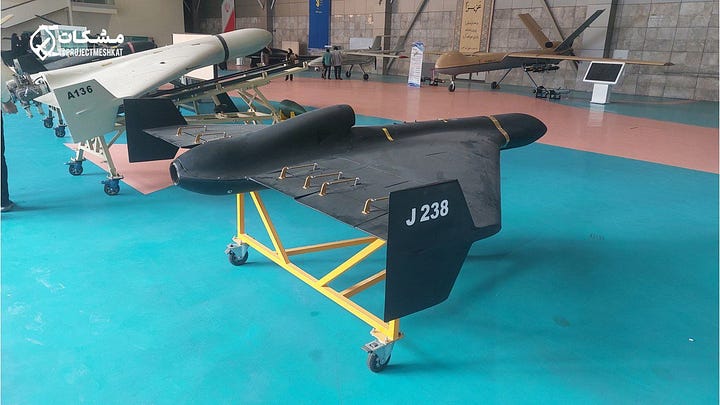
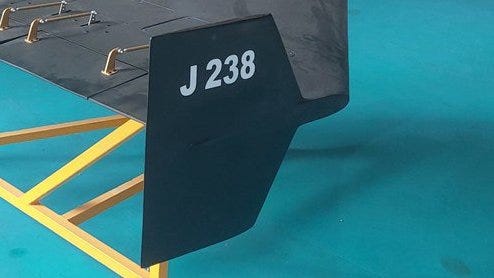
The “Shahed-136 jet” disappeared into relative obscurity following its formal unveiling in September 2024, only to reemerge during the June 2025 Iran-Israel War. Wartime images of debris and official images indicated that the “Shahed-136 jet” was operational and had been built in non-trivial numbers.
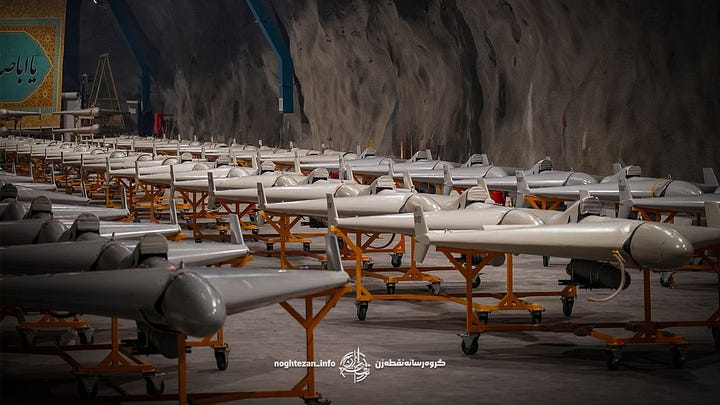
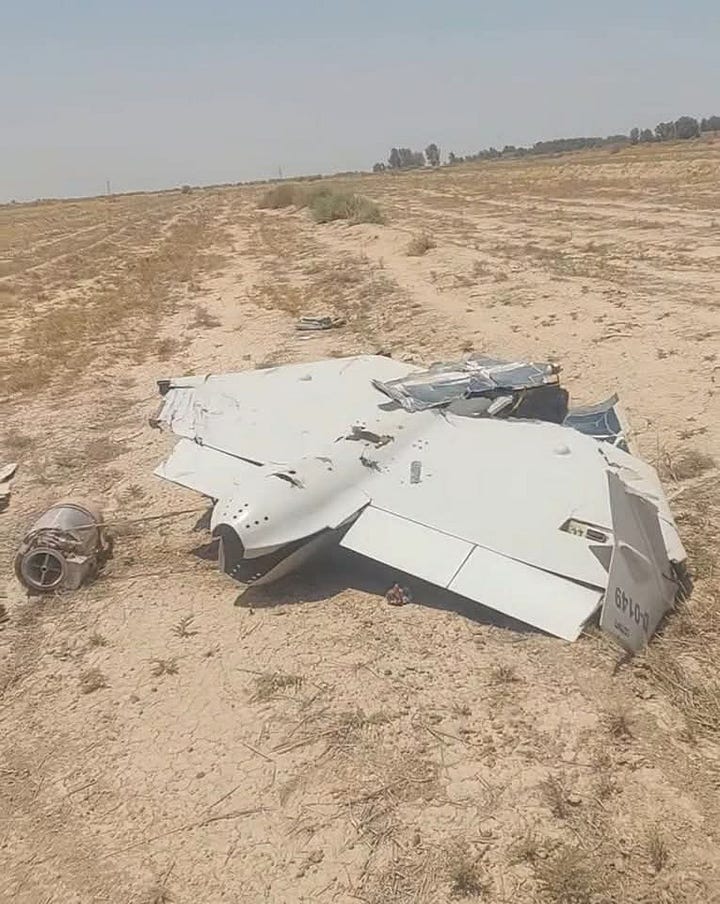
While the “Shahed-136 jet”—not the Shahed-238—appears to be the primarily, if not only, turbojet-powered, cropped delta wing strike drone—winged cruise missile—design deployed by the IRGC Aerospace Force, Iran has developed at least one additional cropped delta wing strike drone design.
In February 2025, the IRGC Ground Force—not the IRGC Aerospace Force, which is the primary operator of the propeller-driven Shahed-136 and seemingly the sole operator of the turbojet-powered “Shahed-136 jet”—unveiled the Golaleh, which appears to be a turbojet-powered derivative of the smaller Shahed-131 from which the much larger and longer-range Shahed-136 is itself derived. The Golaleh has a different engine configuration than both the Shahed-238 and the “Shahed-136 jet”—its turbojet engine is mounted on top of the fuselage in an exposed position without a purpose-built air intake integrated into the fuselage. It does, however, have the same type of wing stabilizers seen on the “Shahed-136 jet” but not the “Shahed-238.” This suggests that the designers at Shahed Aviation Industries have settled on this distinctive wing stabilizer design for use on turbojet-powered, cropped delta wing strike drones—winged cruise missiles.
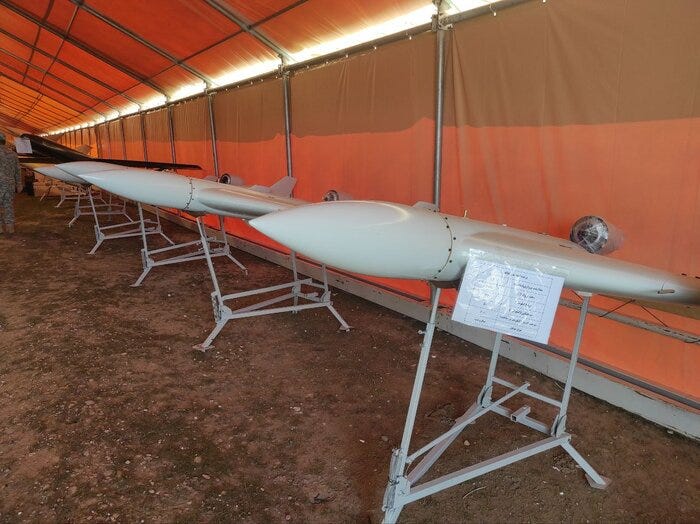
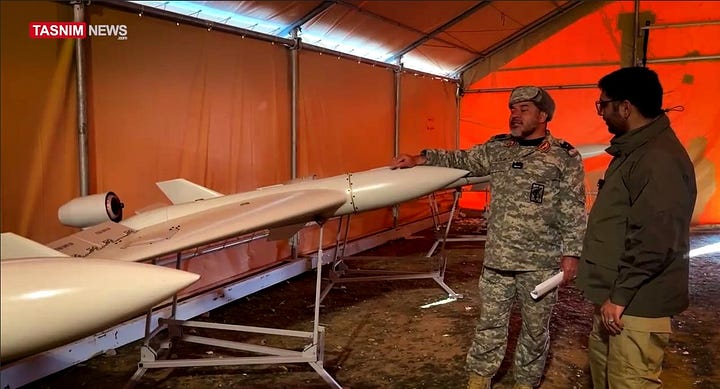
Making Sense Of The Russian Turbojet-Powered Specimen Seen In the Winter Video
The winter video that began circulating on Telegram in June 2025 (hereafter “winter video”) was publicized at a time when Ukrainian officials and media had already begun referring to a turbojet-powered version of the Shahed-136/Geran-2 as the Geran-3. Geran is the Russian military’s designation for its Iranian-origin cropped delta wing strike drones—Geran-1 refers to the smaller, lighter, and shorter-range Shahed-131 from which the Shahed-136 is itself derived. The Shahed-136/Geran-2—and perhaps the Geran-3—are manufactured in Alabuga, Tatarstan. It is important to note that there is a parallel production line in Izhevsk, Udmurtia, which manufactures the closely related Garpiya, which appears to be a reverse-engineered Shahed-136 that incorporates components sourced from China. As of this writing, there is no official documentation of the Geran-3 and the distinctive turbojet-powered version of the Shahed-136/Geran-2 in the winter video may or may not be the Geran-3—it may alternatively constitute a separate and parallel Russian effort, perhaps unsuccessful, toward developing a Russian turbojet-powered derivative of the underlying Shahed-136 airframe that is being manufactured at two Russian production lines.
Ukrainian reports and images of debris indicate that the turbojet-powered Geran-3 uses the new Cyrillic “У” series code. The above image of what is claimed to be a Geran-3 wing stabilizer indicates that it shares the same vertical stabilizer shape that is found on the Shahed-136 and the Shahed-238. The Geran-3 is not, therefore, the “Shahed-136 jet” that Iran formally unveiled in September 2024 and then used against Israel in the June 2025 Iran-Israel War. Not only is the above image of a wing stabilizer with the marking Geran-3 different from the wing stabilizer found on the operational Iranian “Shahed-136 jet,” the winter video is evidently not a “Shahed-136 jet” either.
While the specimen seen in the winter video is not a “Shahed-136 jet,” it also is not consistent with the Shahed-238. It is also different from the Iranian Golaleh, which is to say that the specimen seen in the winter video appears to reflect a distinctively Russian branch of a cropped delta wing strike drone evolutionary tree that originated in Iran. There are, moreover, indications that the specimen in the winter video is an ad hoc modification of a Shahed-136/Geran-2 airframe and not a purpose-built design that is built at one of the two Russian production lines, but this may simply reflect the prototype status of the specimen seen in the winter video.
The above screenshot from the winter video features a cropped delta wing strike drone that is consistent in shape with the Shahed-136/Geran-2/Garpiya.
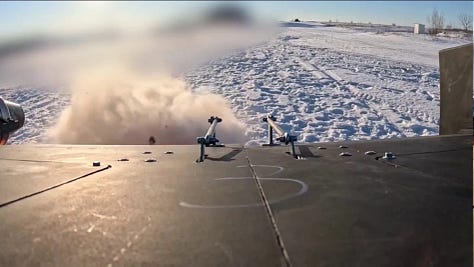
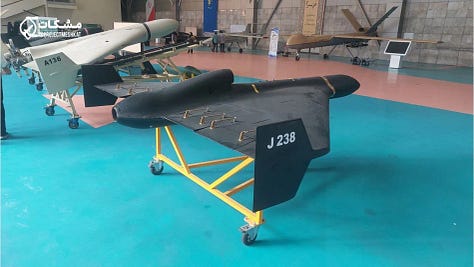
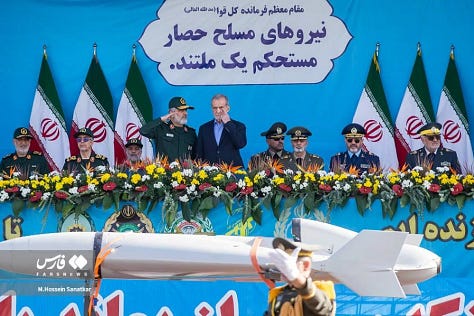
Note the distinctive straight Shahed-136/Geran-2/Garpiya style wing stabilizers, which also appear on the Shahed-238 but not the “Shahed-136 jet” or the Golaleh. Note also the very different manner in which the turbojet is installed on the Russian specimen. The Iranian Shahed-238 and “Shahed-136 jet” integrate the turbojet engine inside the fuselage, and each of the Iranian designs has a (different) purpose-built air intake. The Russian specimen seen in the winter video, however, has an exposed turbojet engine that is mounted on top of the fuselage. While the Iranian Golaleh also has an exposed turbojet engine, the Golaleh is a smaller design and has “Shahed-136 jet” style wing stabilizers, unlike the Russian specimen seen in the winter video.
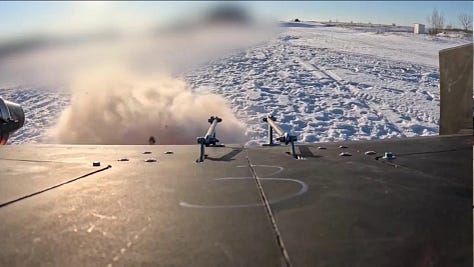
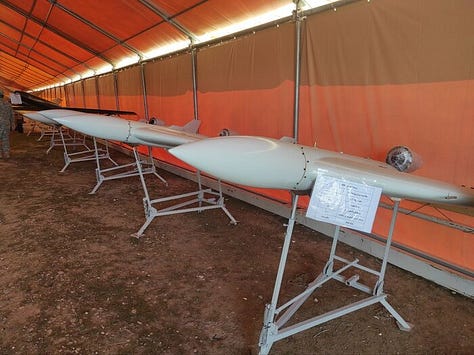
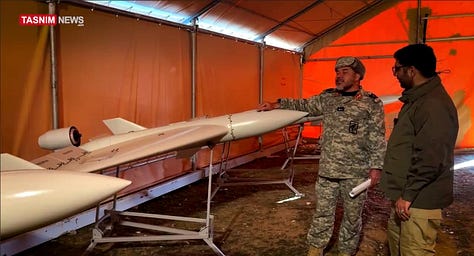
The different approach to engine placement is not the only major difference between the Russian specimen seen in the winter video and the Iranian Shahed-238, which appears to have been supplanted by the “Shahed-136 jet.” At the time of its introduction, the Shahed-238 was not only distinguished from the Shahed-136 by the combination of a turbojet engine integrated into the fuselage and a fixed air intake, but the presence of substantially different control surface actuators. Simply stated, the turbojet-powered Shahed-238 specimens seen to date were likely to have been built in that specific configuration rather than being conversions of existing Shahed-136 airframes. The Russian specimen seen in the winter video, however, has the same control surface actuator arrangement as the propeller-driven Shahed-136/Geran-2/Garpiya.
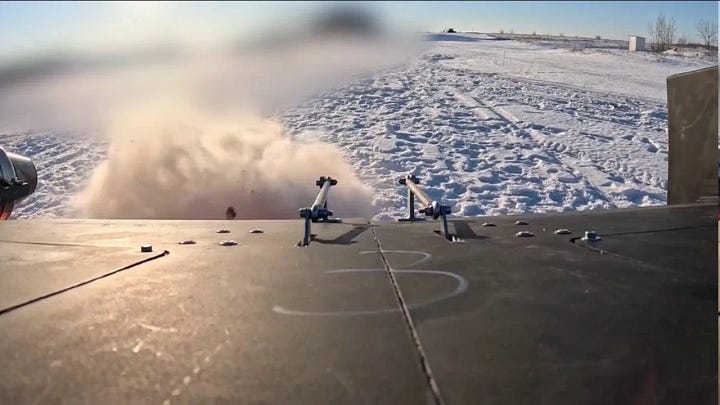
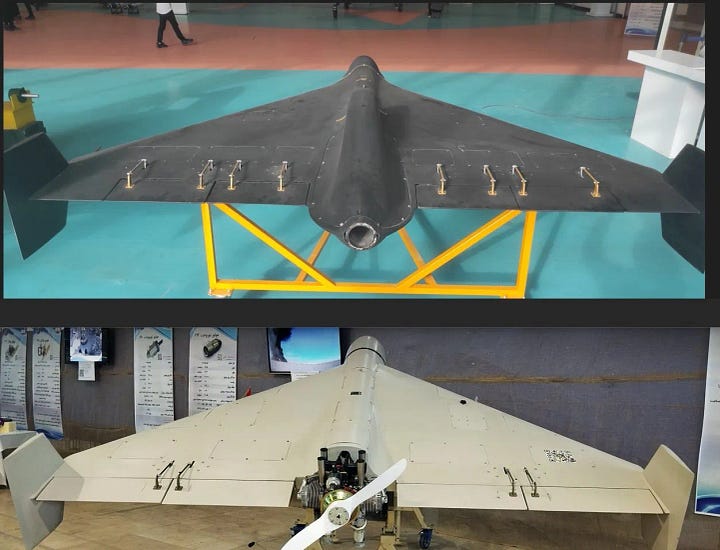
The final distinguishing feature of the Russian specimen seen in the winter video is the existence of an antenna on the port/left wing stabilizer. This antenna design and placement have been seen once before at a military industrial exhibition attended by Russian President Vladimir Putin in September 2024. That particular specimen amounted to a highly modified Shahed-136/Geran-2 airframe that also incorporated a new circular GNSS antenna array and a nose-mounted electro-optical sensor. While Iran has formally and informally unveiled Shahed-136 and Shahed-238 specimens with two different sensor configurations, no publicly known Iranian cropped delta wing strike drone design features this type of antenna on one of the wing stabilizers.
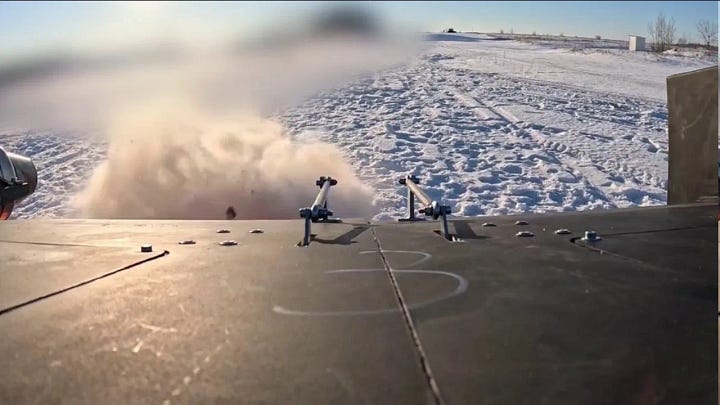

Given the above, the Russian specimen seen in the winter video that began circulating on Telegram in June 2025 is substantially different from the Iranian Shahed-238, the Iranian “Shahed-136 jet,” and the Iranian Golaleh. The Russian specimen seen in the winter video may amount to an ad hoc turbojet-powered version of the Shahed-136/Geran-2/Garpiya airframe that Russia may have developed on its own. The turbojet-powered Geran-3 that Russia is reportedly employing on a limited scale against Ukraine may or may not be related to, let alone the same as, the rather crude specimen seen in the winter video. While uncertainties remain amid the limited information that is publicly available at this time, available information nevertheless suggests that there may exist a distinctively Russian branch of the cropped delta wing strike drone evolutionary tree that originated in Iran.


